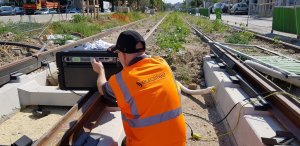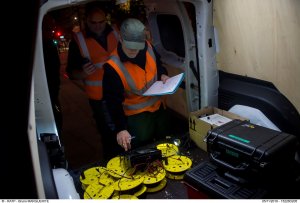Measurements designed for urban light rail systems, either existing or under construction
Our partner laboratory, the RATP Test and Measurement Laboratory (LEM), offers services associated with measuring “The electrical quality of traction return currents”. These measurements are performed on urban light rail lines, like the metro and tram. They are essential for existing networks and those under construction.
Measurements and services for compliance with current regulations
The services provided by our laboratory ensure that the line being inspected complies with standards NF EN 50122-1 and 50122-2, and Title III of the Ministerial Order of 17 May 2001, establishing the technical conditions that electrical energy distributions are required to meet. The purpose of the above two standards is to ensure the electrical safety of people and property in the vicinity of rail infrastructures. The ministerial order recommends that inspections be conducted and measurements performed on new lines, and requires that current continuity on existing lines be checked.
The LEM performs these inspections and measurements to make sure that users are safe and to ensure that there is good insulation from external components, particularly underground installations near the line, such as pipes.
Recommendations for new urban light rail lines
The construction phase of an urban project, such as a new tram or metro line, is a key stage for ensuring that the project will run smoothly. If errors are made during this phase and not corrected, serious consequences may ensue. Title III of the Ministerial Order of 17 May 2001 therefore recommends that inspections be conducted and measurements performed on the insulation of electrical components to ensure that the project progresses correctly.
During the infrastructure approval phase, the State recommends that compliance measurements be taken in line with the relevant standards (NF EN 50122-1 and 50122-2). These measurements will serve as a reference for the periodic inspections conducted on the rail line.

Requirements for existing lines
Regular inspections every five years must be conducted on existing urban lines. The purpose of these inspections is to check several parameters, including:
- Continuity with equipotential connections (rail to rail and track to track) to ensure that the current is properly distributed within the infrastructure;
- Negative return-substation connections used by the current to return to its feeder substation, to ensure that the traction return path is perfectly operational;
- Rail-ground voltage levels to ensure that property and people are well protected.
These regular inspections and measurements can be implemented on any type of network by the LEM. Their purpose is to ensure that the line and surrounding area pose no risk to people or equipment.
Our partner, LEM, has therefore developed a technique that simplifies the measurement process by limiting the works on the infrastructure. This greatly reduces deterioration and damage of the line compared to traditional measuring techniques, generating a substantial economic gain.


Each of the measurements mentioned in this article is essential for all urban light rail systems. They help to ensure good interaction between the various underground urban networks and the railway platform, thus helping to curtail accidents involving people and property.
Article written in collaboration with Rémi GORGE, Manager of the Electricity Division at LEM (RATP)




